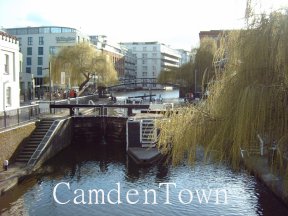Origins of Camden Town
Situated in the London Borough of Camden, just north of Holborn and Bloomsbury, Camden Town has developed
from an area of rural open fields in the 1870s - to the bustling urban centre of markets, coffee shops, restaurants and hubs
of music and alternative cultures that it is today.
In 1791, Charles Pratt, the first Earl Camden, (of whom Pratt Street in the heart of town is named after)
initiated it's original transformation together with subsequent wealthy individuals who further
saw the potential of developing the area. Between 1820-1850 the emergence of the railways and the Regent's and Grand Union
Canals to commerce and travel flows resulted in Camden 's further growth. By 1907, with the opening of Camden Town tube station,
Camden was already a noted major centre for shopping and entertainment with direct links into the wider city centre of London.
Further regenerations projects throughout the 1960s together with the conversions to the famous craft
markets along the Regent's Canal's wharves and warehouses in the 1970s ensured Camden Town's future as one of London's top
tourist attractions.
It’s popularity has been boosted further by being home to some impressive examples of literary history
and beauty - from it’s links to Charles Dickens and Dylan Thomas and the house of the poets Rimbaud's and Verlaine to
the inspiring Regent’s Park, the canal walks that pass London Zoo or the ‘quiet jewel in the city’ that
is Camley Street Natural Park, five minutes from the new St Pancras International station. Overall it is this diverse mix
and Camden’s nationally and internationally discussed legacy as a place that is home to creative types in the arts,
media, fashion and music industries that continues to further Camden's reputation as now one of Europe's most significantly
popular cultural tourist hotspots as well as being a great place to live, work or study.

